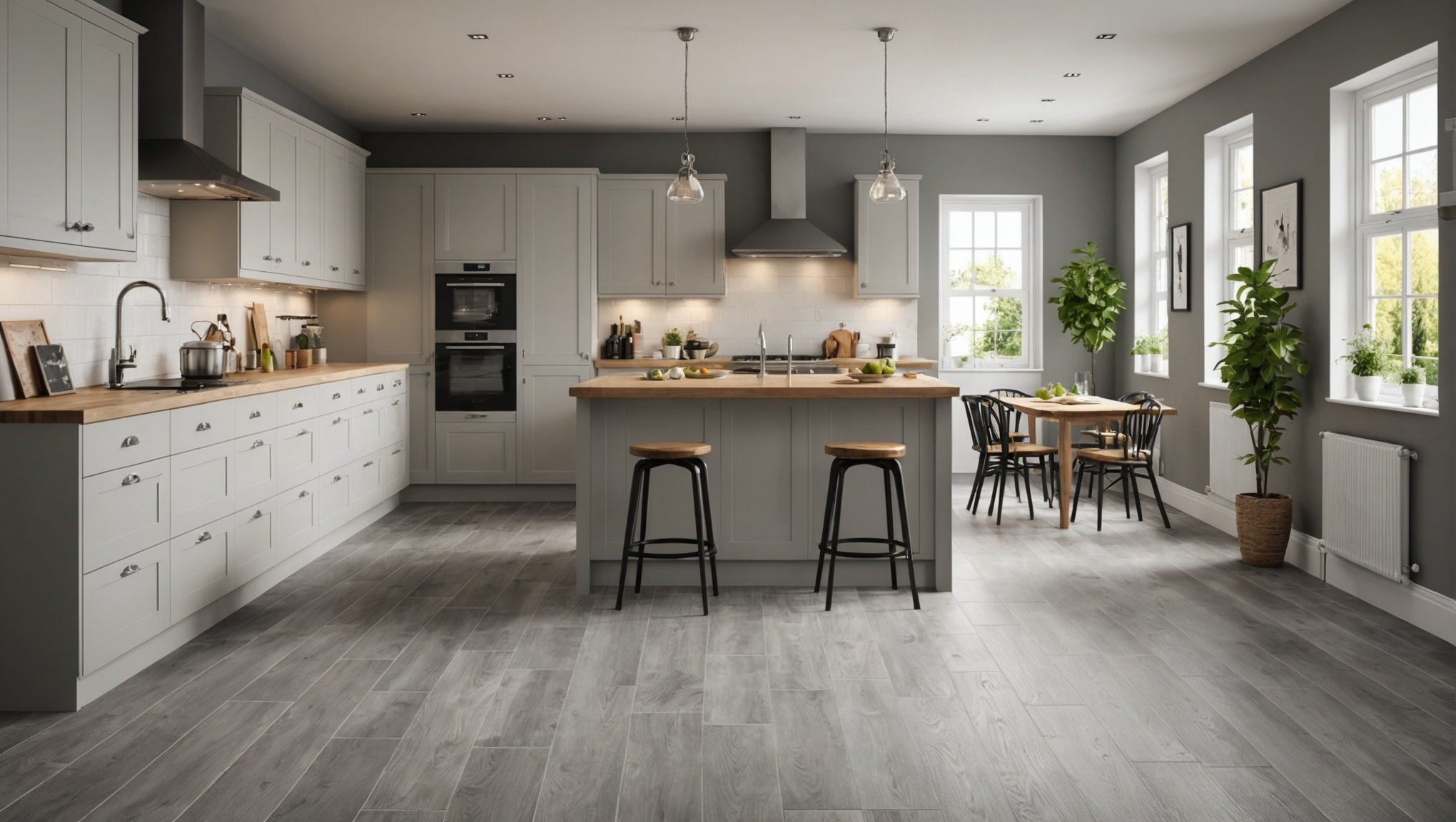Finding the ideal flooring for UK kitchens featuring underfloor heating can transform your space into a cozy haven. Considerations like material, insulation, and aesthetics are essential. The right choice not only enhances comfort but also elevates your kitchen’s overall appeal. Explore practical tips and insights to ensure your flooring meets both functionality and style, making every step in your kitchen a delightful experience. Let’s uncover the best options tailored to your needs.
Overview of Flooring Options for UK Kitchens
When selecting flooring options for UK kitchens, it’s essential to consider both functionality and style. Various kitchen flooring materials are available, each offering unique benefits. Popular choices include ceramic tiles, vinyl, laminate, and natural stone. Ceramic tiles are favoured for their durability and water resistance, making them ideal for high-traffic areas. Vinyl is a versatile option, known for its affordability and ease of maintenance. Laminate provides a wood-like appearance without the cost, while natural stone offers timeless elegance.
Topic to read : Mastering Kitchen Design: A Step-by-Step Guide to Planning Your UK Terraced House Layout
Compatibility with underfloor heating is a crucial factor in the UK climate. Many kitchens benefit from this heating method, especially during colder months. Ceramic tiles and stone are excellent conductors of heat, making them suitable choices for underfloor heating systems. Vinyl and laminate can also work well, but it’s essential to ensure they are specifically designed for such use to avoid damage.
Considering the UK’s often damp and cool climate, selecting materials that can withstand moisture and temperature fluctuations is vital. Opting for flooring that combines practicality with aesthetic appeal will ensure a long-lasting and comfortable kitchen environment. By evaluating these factors, homeowners can make informed decisions that enhance their kitchen’s functionality and style.
Also to discover : Stylish Strategies for Seamlessly Incorporating a Wine Cooler into Your UK Kitchen Design
Detailed Comparison of Flooring Types
Selecting the right flooring for your kitchen can be a daunting task. Each type offers distinct benefits and drawbacks, influenced by your needs and preferences.
Tiles
Tiles are a classic choice for kitchen flooring. They offer several advantages, including durability and water resistance. These qualities make them ideal for high-traffic areas. However, tiles can be cold underfoot and may require rugs for comfort. When combined with underfloor heating, tiles excel due to their excellent heat conduction. Popular materials include ceramic and porcelain, each providing a sleek and stylish finish.
Vinyl
Vinyl flooring is known for its affordability and ease of maintenance. It is water-resistant and can mimic the appearance of more expensive materials. However, it may not be as durable as other options and can dent or scratch. Vinyl performs well with underfloor heating if specifically designed for it. It is best suited for kitchens where budget and practicality are priorities.
Laminate
Laminate flooring offers a wood-like appearance without the high cost. It is easy to install and maintain but can be susceptible to moisture damage if not properly sealed. With underfloor heating, laminate can be effective, provided it is compatible. Regular cleaning and avoiding excess moisture are essential for maintaining its longevity and appearance.
Advantages of Underfloor Heating in Kitchens
Underfloor heating offers numerous benefits that enhance kitchen comfort, especially during the colder months. This heating method provides an even distribution of warmth, eliminating cold spots and ensuring a cosy environment. Unlike traditional radiators, underfloor heating warms the room from the ground up, creating a consistent temperature throughout the kitchen.
One of the primary benefits is its efficiency in heat distribution. By covering a larger surface area, underfloor heating systems are able to maintain a steady temperature using less energy compared to conventional heating systems. This not only results in a more comfortable living space but can also lead to reduced energy bills.
Compatibility with various flooring types is another significant advantage. Ceramic tiles and natural stone, known for their excellent heat conduction, work exceptionally well with underfloor heating. Vinyl and laminate can also be used, provided they are designed for such systems. This versatility allows homeowners to choose from a range of flooring materials without compromising on warmth and comfort.
By opting for underfloor heating, homeowners can enjoy a warm and inviting kitchen that combines modern technology with practical design, ultimately enhancing the overall functionality and appeal of their home.
Installation Tips for Flooring with Underfloor Heating
When considering flooring installation with underfloor heating, preparation is key to a successful outcome. Begin by ensuring your kitchen subfloor is clean, dry, and level. This foundation is crucial for the longevity and efficiency of both the flooring and heating system.
Preparing Your Kitchen for Installation
Before installation, remove all existing flooring and inspect the subfloor for any damage or moisture issues. Address these problems promptly to prevent future complications. It’s also wise to plan for the layout of your heating system, ensuring it covers the desired areas without overlapping or gaps.
Recommended Installation Techniques
For optimal results, follow the manufacturer’s guidelines for both the flooring and heating system. This often includes using specific adhesives or underlays that enhance heat conduction and protect the materials. Pay attention to expansion gaps, especially with materials like laminate, to accommodate temperature fluctuations.
Common Mistakes to Avoid
Avoid these pitfalls to ensure a smooth installation:
- Skipping subfloor preparation can lead to uneven heating and floor damage.
- Using incompatible materials may reduce heating efficiency or cause warping.
- Failing to test the heating system before laying the flooring can result in costly repairs.
By adhering to these tips, you can achieve a well-installed floor that maximises the benefits of underfloor heating.
Cost Analysis of Flooring Options
When planning for kitchen flooring, understanding flooring costs is essential for effective budget planning. Each material comes with its own price range, impacting both initial expenditure and long-term investment.
Tiles, such as ceramic or porcelain, typically have a higher upfront cost due to their durability and aesthetic appeal. Prices can range from £20 to £50 per square metre, excluding installation. However, their longevity often justifies the initial expense, making them a sound investment over time.
Vinyl flooring is a more budget-friendly option, with costs generally between £10 and £30 per square metre. This affordability, combined with ease of maintenance, makes vinyl an attractive choice for cost-conscious homeowners. While it may not offer the same longevity as tiles, its lower initial cost can be appealing.
Laminate flooring offers a middle ground, priced around £15 to £40 per square metre. It provides a wood-like appearance without the high price tag of natural wood, offering a balance between cost and aesthetic.
When considering installation services, prices can vary significantly. Professional installation for tiles may be more expensive due to the complexity of the process, whereas vinyl and laminate are often easier and cheaper to install. Balancing these factors is key to making a well-informed decision.
Maintenance of Kitchen Flooring with Underfloor Heating
Ensuring the longevity of your kitchen flooring with underfloor heating requires consistent flooring maintenance and specific care tips tailored to the type of material you have chosen.
Regular Maintenance Routines
Adopting a regular maintenance routine is crucial. For all flooring types, sweeping or vacuuming to remove debris is recommended to prevent scratches. Mopping with a damp cloth helps maintain cleanliness, but avoid excessive water, especially on laminate.
Specific Care for Different Flooring Types
Different flooring materials require varied care strategies. Ceramic tiles benefit from periodic resealing to maintain their water resistance. For vinyl flooring, avoid harsh chemicals that might damage the surface; instead, use a mild cleaner. Laminate flooring demands careful attention to moisture levels—ensure spills are promptly cleaned to prevent warping.
Impact of Underfloor Heating on Flooring Longevity
Underfloor heating can influence the lifespan of your flooring. While it offers consistent warmth, it can exacerbate wear if not properly managed. Ensure the heating system is compatible with your chosen flooring to avoid damage. Regularly check for any signs of wear or warping, adjusting the heating settings as necessary to maintain optimal conditions.
Recommendations Based on UK Climate
When selecting kitchen flooring in the UK, it’s crucial to consider the UK climate considerations. The UK’s often damp and cool conditions necessitate materials that can withstand moisture and temperature fluctuations.
Best Flooring Materials for Damp Conditions
In damp conditions, ceramic tiles and natural stone are excellent choices due to their water resistance and durability. These materials can handle moisture without compromising their integrity, making them ideal for kitchens.
Performance of Various Materials in Fluctuating Temperatures
Vinyl flooring is another viable option, particularly in fluctuating temperatures. Its flexibility allows it to adapt without warping, provided it is of high quality and properly installed. Laminate flooring can also perform well, but it requires careful sealing to protect against moisture damage.
Regional Considerations Within the UK
Regional differences within the UK, such as coastal areas with higher humidity, may influence flooring choices. In these regions, prioritising materials like tiles or stone that resist moisture is wise. Conversely, in drier areas, laminate or vinyl could be more suitable, offering a balance between cost-effectiveness and performance.
By considering these factors, homeowners can make informed decisions that align with the unique demands of the UK climate, ensuring a durable and comfortable kitchen environment.
Expert Insights and User Testimonials
Gaining insights from flooring professionals and real-life user experiences can significantly aid in choosing the right kitchen flooring. Professionals often highlight the importance of selecting materials that align with both aesthetic desires and practical needs. For instance, a flooring expert might suggest ceramic tiles for their durability in high-traffic areas, while recommending vinyl for budget-conscious homeowners seeking easy maintenance.
Quotes from Flooring Professionals
- “Choosing the right flooring is about balancing style with functionality,” says a renowned flooring specialist. “Consider your kitchen’s specific demands, like moisture levels and footfall, before making a decision.”
Case Studies of Successful Installations
One notable case study involved a family in Manchester opting for natural stone in their kitchen. They reported increased satisfaction due to the material’s ability to withstand the UK’s damp climate while providing an elegant look. The installation was praised for its seamless integration with underfloor heating, offering both style and warmth.
User Testimonials on Flooring Performance
Users frequently commend vinyl for its affordability and resemblance to pricier materials. A homeowner in London shared, “Our vinyl floor looks fantastic and has held up well despite our busy kitchen.” Such testimonials underscore the importance of aligning product choice with lifestyle needs and environmental conditions.
Visuals and Resources for Flooring Selection
Selecting the right kitchen flooring is a task that often benefits from visual aids and comprehensive resources. With the variety of options available, flooring resources can simplify the decision-making process.
Infographics are a valuable tool, providing a visual comparison of various flooring types. These guides often highlight key features such as durability, cost, and compatibility with underfloor heating. By presenting information in a clear and concise format, infographics assist homeowners in quickly understanding the pros and cons of each material.
Visual examples of kitchens featuring different flooring types can also be incredibly helpful. Seeing how a particular flooring material looks in a real-world setting aids in visualising how it might fit into your own kitchen design. Such examples can inspire creativity and help match aesthetic preferences with practical needs.
While written resources and guides are plentiful, seeing these materials in action can be more impactful. Whether through online galleries or magazines, these visual aids complement traditional guides, offering a holistic view of potential choices. By leveraging these visual guides, homeowners can confidently navigate the wide array of options, ensuring a choice that balances style, function, and budget.












